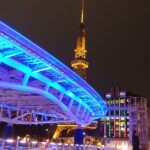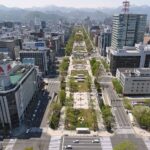There are numerous bus lines, tram lines, and train lines that service the city of Yokohama in Japan. The JR East train line connects Yokohama to Tokyo and other cities in the region, while the city’s massive bus network serves all regions of the city. The Yokohama Municipal Subway consists of two lines that run underground and connect Yokohama Station with the city’s southern neighborhoods. There is also a ferry system that runs from downtown to several neighborhoods in the Tokyo Bay area. Shinkansen, a high-speed rail line, also links Yokohama to Tokyo and other cities in the vicinity.
Metro system in Yokohama – 横浜市営地下鉄
The Yokohama Metro is a significant public transit system in Yokohama, Japan. Two lines connect the downtown area with the suburbs: the Blue Line and the Green Line. It connects many of the city’s most popular tourist destinations and features 42 stops. The Yokohama City Transportation Bureau runs the system, keeping it clean and up to date. It’s also convenient because the city’s bus and taxi systems are interconnected.
Blue Line (Yokohama Shiei Chikatetsu Bur Rain) – “B”
The Yokohama City Transportation Bureau operates the Yokohama Municipal Subway, which includes two lines with a combined length of 40.4 kilometers, making it the second-longest subway line in Japan after Tokyo’s Toei Oedo Line (which is 40.7 kilometers in length). It is powered by a third rail rather than overhead lines like the rest of Japan’s metro systems. It’s the newest steel-wheeled railroad to open in Japan. Line 3 runs between Azamino in Aoba-ku, Yokohama, and Kannai, while Line 1 runs between Kannai and Shnandai in Fujisawa. Lines 1 and 3 provide non-stop service for both local and fast services. Since the Green Line didn’t officially open until March 2008, it’s been referred to as the “Blue Line” since then. The line is blue, and the station designation B is the line symbol.
Green Line (Yokohama Shiei Chikatetsu Gurn Rain) – “G”
The Yokohama Municipal Subway is managed by the Yokohama City Transportation Bureau, and this line is the shorter of the two. The first segment of the Yokohama Circular Railway to open, it is formally known as Line 4. The Green Line stretches for 13.0 kilometers and has 10 stops, connecting Nakayama on the JR East Yokohama Line with Hiyoshi on the Tokyu Toyoko Line. The trip takes around 21 minutes one way and is propelled by a linear motor.
Map of Yokohama Metro 2024 – Free Download in PDF

Click and download the map of Yokohama’s underground system for 2024
To help you get around the city, we’ve provided you with a Yokohama Metro Map 2024. It’s a downloadable PDF that’s up-to-date and comprehensive, covering all of the metro’s stops, lines, and connections. It’s a helpful tool for visitors to the city because it eliminates the hassle and confusion of figuring out your way around. With the map in hand, you can plot the most direct course to your destination and feel more at ease as you make your way through Yokohama.
Public transport tickets – actual prices
The city of Yokohama has an excellent and cheap public transportation system. Locals and tourists alike can easily navigate around the city thanks to its convenient public transportation system. It’s crucial to know the many types of tickets and fares that are offered before booking a trip.
The Yokohama City Subway and Bus One-Day Pass is the most often used method of public transportation. This card costs 800 JPY (about $7 USD) and allows you unlimited use of the subway and bus system for the day. In addition, you can purchase a Tokyo 1-Day Ticket. This ticket costs 1,580 JPY (about $14 USD), and it grants the holder unrestricted usage of all Toei subway and bus lines in Tokyo.
The Yokohama City Subway and Bus Three-Day Pass could be the ideal option for travellers staying in Yokohama for numerous days. For 2,200 JPY, or around $20 USD, you can take unlimited rides on train and bus routes for three consecutive days. You can save money on admission to some sights and shopping with this pass.
The Yokohama City Subway and Bus Three-Day Pass is the greatest value for visitors staying in the city for three days. It offers free travel on the subway and buses, as well as savings at local businesses. Visitors who plan to spend numerous days in the city can save a lot of money by purchasing a 3-day pass for 2,200 JPY (about $20 USD).
Timetables & Schedules of Yokohama Metro system
The Yokohama Metro runs from 5:00 am to 12:00 am, with peak-hour service every few minutes and off-peak service every 10-15 minutes. The metro operates daily from 5:00 AM to 12:00 AM, with the final train leaving the final station at 11:30 PM. The metro runs from 5:00 am to 11:30 pm on weekends and holidays, with the last train leaving its final station at 11:00 a.m. You should check the timetable before taking the metro in Yokohama, as it may operate for extended hours during specific times of the year, such as the New Year’s holidays.
What Are Other Options For Public Transportation In Yokohama?
The metro isn’t the only form of public transit in Yokohama. For instance, the Yokohama City Transportation Bureau oversees the city’s bus system and the three-line Yokohama Municipal Subway. Local trams are also widely utilized, both by residents and visitors. Many boats also run from Yokohama to Kawasaki and other adjacent cities and islands. Lastly, you can take the Yokohama Bay Shuttle to get around the bay. Transportation in Yokohama is convenient and inexpensive because to all of these choices.
city bus transportation in Yokohama
The Yokohama City Transportation Bureau is responsible for the city’s public bus system. There are both regular city buses and faster express buses in this system. Local buses are utilized for shorter journeys, whereas longer ones necessitate the usage of express buses. The majority of buses can accommodate passengers using wheelchairs, bicycles, and baby strollers, and all buses have air conditioning.
The hours of operation for Yokohama’s public buses are from 5 a.m. to 11:30 p.m. Buses are color-coded according to route, and stops and terminals are plainly labeled on the exterior. Every one of the city’s many bus stops has English and Japanese language signs for your convenience. You can either buy a ticket from the bus driver or use a prepaid card.
The Number 4 bus is a popular option for getting around Yokohama, as it departs from Yokohama Station and travels past many of the city’s most well-known attractions, such as Minato Mirai 21, Chinatown, and Yokohama Stadium. Getting from Yokohama Station to Sakuragicho Station is a breeze with the Number 5 bus. Getting from Yokohama Station to Yokohama Arena is a breeze on the Number 1 bus.
These are only a few of the most well-known bus lines in Yokohama; there are many others that serve the city and its surroundings. The city’s bus system is enormous and well-run, making travel within and around it a breeze.
city and inter-city TRAINS in Yokohama
JR East and the Yokohama Municipal Subway are the two primary rail providers in the city. Yokohama is connected to the rest of the Kanto area via JR East’s Tokyo Metro and Yokohama Lines.
The Shonan-Shinjuku Line connects Yokohama and Tokyo; the Sotetsu Line connects Yokohama and Kawasaki; the Keikyu Line connects Yokohama and Tokyo’s Haneda Airport; and the Tokaido Line connects Yokohama and other cities in the Tokaido region.
Narita Express, which runs between Yokohama and Narita Airport; Shinkansen, which runs between Yokohama and various cities along the Tokaido Shinkansen Line; and Keisei Skyliner, which runs between Yokohama and Narita Airport, are just a few of the many express trains that Yokohama has to offer.
There are also several bus routes in Yokohama for people who choose a less time-consuming mode of transportation. Yokohama is well connected by bus to the rest of the Kanto area and the rest of Japan.
Finally, Yokohama is connected to the ports of Tokyo and other cities in the Kanto region via a variety of ferry services.
From Yokohama Airport (YOK) To The City Center
Getting from Yokohama International Airport to the heart of the city is a breeze because to the convenient public transit choices. Yokohama is the largest city in Kanagawa Prefecture and the second largest in Japan. There are several quick and easy options for getting from the airport to the heart of the city, whether you’re a tourist or a resident.
The Keikyu Airport Line is the most common choice. From the airport, you may take the train to Yokohama Station in the heart of the city. The train is the best option for people who are in a hurry because it is quick, dependable, and operates frequently. The train travel is about 35 minutes long and costs 610 for a single ride.
The Yokohama City Airport Terminal Bus is a less expensive alternative. It takes about 50 minutes on this bus to get from the airport to Yokohama Station. Each one-way ticket costs $400.
Taxis are another alternative for getting from the airport into the heart of the city, but they will cost you quite a bit more. A cab ride in one direction will run you about 7,000.
Getting from Yokohama Airport to the heart of the city is simple and quick in either direction you choose. You can travel wherever you need to go quickly and easily thanks to the excellent network of public transportation services.
how to spend 3 days in Yokohama?
Yokohama is a thriving metropolis brimming with fascinating sights, sounds, and experiences. It doesn’t matter if you’re a first-time visitor or a seasoned explorer; there will always be something fresh and thrilling to discover. If you only have three days in the city, you can still have an unforgettable experience.
Day 1 – Daisho-in Temple,
Daisho-in Temple, one of Yokohama’s oldest and most beautiful temples, should be your first stop. The beautiful gardens of this temple are home to statues of numerous deities. There are several statues of animals, as well as the Buddhist goddess of compassion, Kannon. Take a trip into Chinatown after seeing the temple to try some authentic regional specialties.
Day 2 – Busty port
Spend your second day in the city wandering around the busy port. The famous Yokohama Red Brick Warehouse is located here, along with many other businesses and eateries. In its original form, this structure served as a customs office beginning in 1911. It’s been renovated into a trendy shopping and dining center with multiple levels.
Day 3 – VIBRANT NIGHTLIFE
On your last night in Yokohama, take advantage of the city’s vibrant nightlife. Visit one of the city’s many izakayas to kick off the night. Try some of the greatest sake and beer in town while snacking on authentic regional specialties. Go out to one of the city’s many nightclubs, bars, or karaoke rooms after dinner. Yokohama’s nightlife caters to those looking to both get their groove on and unwind with friends.
Three days in Yokohama can be spent in a variety of ways, each of which will be unique and enjoyable in its own way. Yokohama is a fantastic vacation spot for a variety of reasons, including its old temples and Chinatown and its exciting nightlife.
What other metro systems are nearby to Yokohama?
Japan, known for its technologically advanced public transportation system, has several metro systems apart from just Tokyo. Cities like Osaka, Nagoya, Kyoto, Yokohama, Kobe, and Fukuoka also boast highly efficient metro systems. The Osaka Metro serves millions of people daily with its eight lines, while the Nagoya Municipal Subway is Japan’s third-largest metro system. Kyoto’s two-line subway caters to the city’s numerous tourists and locals alike. Yokohama’s metro, although smaller, connects seamlessly with Tokyo’s extensive network. Kobe’s two-line system serves the city and its suburbs, while Fukuoka’s metro is the primary mode of transportation on the island of Kyushu. Each of these metro systems contributes to Japan’s reputation for punctuality, cleanliness, and convenience in public transportation.
VIDEO TOUR GUIDE ABOUT PUBLIC TRANSPORTATION IN Yokohama
Summary of our tour guide for Yokohama
For the past four years, my home has been in Yokohama, so I have had ample opportunity to use the city’s public transit system. Getting about Yokohama is a breeze because to the city’s excellent public transit network. I’ve taken advantage of the area’s bus, train, and ferry services, and can attest that they’ve all been reliable, spotless, and pleasant. The railways are quite helpful since they link all the important parts of the city together. Tickets are cheap, making this a great option for getting about Yokohama. To go around the city, I highly recommend using Yokohama’s excellent public transit system.
Top 5 FAQs and answers about Yokohama public transport?
- Where can I find information about Yokohama’s public transportation options?
- Commuter trains, subways, and buses all make up Yokohama’s public transportation network. Along the shoreline, you may also catch water buses and ferries. The city is also accessible via private railways and highway buses.
- How much do tickets cost?
- In Yokohama, the cost of taking any kind of public transportation is determined by the distance traveled. risen to 6 kilometers is covered for 200, then the price goes risen from there. Students and elders can get a discount, too.
- How do I get a ticket?
- Each station includes a ticket machine where you can buy your ticket. In some areas, you can also find ticket booths and vending machines. Prepaid IC cards, like Suica and Pasmo, can also be used to purchase tickets.
- I have a question about pricing:
- Student and elder discounts are available. There is a 50% discount for students between the ages of 6 and 15, and a 20% discount for elders 65 and up.
- Five, I’m lost; how do I travel around town?
- Taking public transportation is the most efficient method of navigating the city. The trains are quick and convenient, and there are buses that go everywhere in the city. The waterfront can be discovered via water bus or ferry.
Useful links







